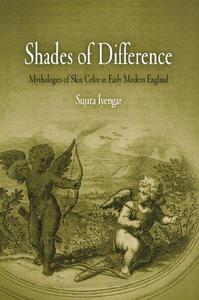
Shades of Difference: Mythologies of Skin Color in Early Modern England By Sujata Iyengar
2005 | 310 Pages | ISBN: 081223832X | PDF | 17 MB
Was there such a thing as a modern notion of race in the English Renaissance, and, if so, was skin color its necessary marker? In fact, early modern texts described human beings of various national origins--including English--as turning white, brown, tawny, black, green, or red for any number of reasons, from the effects of the sun's rays or imbalance of the bodily humors to sexual desire or the application of makeup. It is in this cultural environment that the seventeenth-century London Gazette used the term black to describe both dark-skinned African runaways and dark-haired Britons, such as Scots, who are now unquestioningly conceived of as white.In Shades of Difference, Sujata Iyengar explores the cultural mythologies of skin color in a period during which colonial expansion and the slave trade introduced Britons to more dark-skinned persons than at any other time in their history. Looking to texts as divergent as sixteenth-century Elizabethan erotic verse, seventeenth-century lyrics, and Restoration prose romances, Iyengar considers the construction of race during the early modern period without oversimplifying the emergence of race as a color-coded classification or a black/white opposition. Rather, race, embodiment, and skin color are examined in their multiple contexts--historical, geographical, and literary. Iyengar engages works that have not previously been incorporated into discussions of the formation of race, such as Marlowe's Hero and Leander and Shakespeare's Venus and Adonis. By rethinking the emerging early modern connections between the notions of race, skin color, and gender, Shades of Difference furthers an ongoing discussion with originality and impeccable scholarship.
Fikper
tzi8h.S.o.D.M.o.S.C.i.E.M.E.rar.html
Rapidgator
tzi8h.S.o.D.M.o.S.C.i.E.M.E.rar.html
NitroFlare
tzi8h.S.o.D.M.o.S.C.i.E.M.E.rar
Uploadgig
tzi8h.S.o.D.M.o.S.C.i.E.M.E.rar

